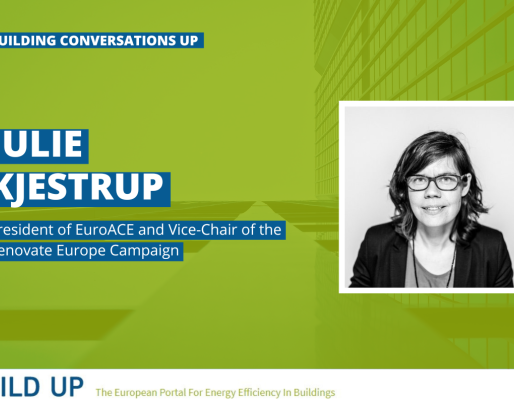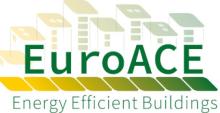Julie Kjestrup: "Energy efficient renovation is about meeting climate targets and lowering energy dependence, but also about delivering on social benefits"

Julie Kjestrup: "Energy efficient renovation is about meeting climate targets and lowering energy dependence, but also about delivering on social benefits"
BUILDING CONVERSATIONS UP WITH... Julie Kjestrup, President of EuroACE and Vice-Chair of the Renovate Europe Campaign. Head of Policy and Thought Leadership, EU and Global at VELUX.
Julie Kjestrup has been the President of EuroACE since January 2023 and the Vice-Chair of the Renovate Europe Campaign since January 2022. She is also Head of Policy and Thought Leadership for VELUX. Prior to that, she was Head of EU Affairs and interim Global Head of Public Affairs and Sustainability at Danfoss. Julie also headed the Brussels Energy and Environment practice at APCO Worldwide, a global public affairs and strategic communication agency. Julie has extensive experience working on all aspects of advocacy and stakeholder engagement and has witnessed first-hand, and contributed to, the rise of energy efficiency on the European policy agenda over the past few years.
Twitter profile
LinkedIn profile
Build Up: You’re the new President of EuroACE and have also been the Vice-Chair of the Implementation Support Group of the Renovate Europe Campaign for the past year already. What is the mission of these initiatives?
Julie Kjestrup: EuroACE is the European Alliance of Companies for Energy Efficiency in Buildings. We’re celebrating our 25th anniversary this year, and our membership includes Europe’s leading companies involved with the manufacture, distribution, and installation of a variety of energy savings goods and services. Our mission then and now is to move Europe towards an efficient use of energy in buildings. To help achieve that, EuroACE took the initiative to set up the Renovate Europe Campaign in 2011. It is the only EU-wide campaign that focuses exclusively on ambitious renovation of the building stock in the EU and is a broader set-up with close to 50 partners at EU and national member state level. In all the work we do, it is important for us to take a technology neutral, integrated and holistic approach and to highlight the multiple benefits of energy efficiency in buildings across lower energy usage and prices, climate protection, job creation, improved well-being and energy security.
BUP: Improving the European building stock is central to all the work you do. What are the steps needed to increase the European renovation rate? What are the barriers for these renovations to be as energy efficient as possible?
JK: Increasing the energy performance of buildings with a strong focus on the existing building stock has always been our raison d’etre, but of course the current context of the war in Ukraine and the ensuing high energy prices have made the aspects of decreasing energy dependence and energy usage very high on everyone’s agenda, not just ours. This high-level political attention is as an opportunity that we should make the most of. The steps that we need to take have not changed much, though.
First of all, a clear regulatory framework which sets targets to be reached within a set timeframe will be transformational in stimulating action and driving investment into the building sector. This will contribute to increasing workforce capacity and to lowering the renovation costs thanks to an economy of scale as demand increases.
The lack of clear targets up till now and the highly fragmented nature of the buildings sector, of which over 95% are SMEs has led to the current situation of inertia and a stubbornly low renovation rate which still hovers at 1%, of which only 1 in 5 are deep renovations.
We believe that providing regulatory impulse into this sector via minimum energy performance standards (MEPS) as laid out in the revised Energy Performance of Buildings Directive (EPBD) is very important in this regard as a wake-up call to ramp up action to achieve the agreed 2030 and 2050 climate goals.
Revising and reinforcing the EPC framework by increasing the quantity and quality of energy performance certificates, including reliable accreditation system for evaluators, runs in a similar vein by firming up the qualitative and interpretation of data.
"We believe that providing regulatory impulse into this sector via minimum energy performance standards is very important as a wake-up call to ramp up action to achieve the agreed 2030 and 2050 climate goals"
And finally, a number of enabling elements need to be put in place. These include one-stop shops, increased financing (especially private), to complement the money already there via NRRPs, Cohesion funds, national budgets etc. and increasing the supply chain capacity, both in terms of materials and skilled professionals. For the latter, we hope that 2023 being EU Year of Skills will allow us to make a big leap forward.
And the barriers? Largely the lack of the above, combined with the complexity of energy efficiency renovations and an overall lack of public awareness of the multiple benefits of renovation.
BUP: What are currently the main barriers for the renovation of EU historic and heritage buildings?
JK: There are different challenges concerning the renovation of historic buildings. A large proportion of the EU building stock falls into this category, though we don’t have a precise number. We estimate that around 30 per cent of our buildings were built prior to 1945 which means they can fall into the category of historic, heritage or protected buildings. A lot of them are highly energy inefficient and amongst the worst-performing buildings in terms of energy consumption.
The reason why we don’t have a firm idea of how many buildings fall into the category is because there is no one definition of what constitutes a historic building across Europe. The many different definitions add complexity, further reinforced by the widespread belief in many member states that such buildings cannot be touched and should be exempt of undergoing any renovation works as those might endanger their cultural value.
"We don’t have a firm idea of how many buildings fall into the category is because there is no one definition of what constitutes a historic building across Europe"
Therefore, it is essential to get the point across that energy efficiency in historic buildings is not just needed, but also feasible. We have a lot of experience in that regard across the sector. Renovate Europe, for instance, showed in its 2019 exhibition that it is possible to renovate our historic buildings following a tailor-made renovation approach to preserve their cultural and architectural merit while improving their energy performance and the living conditions of their occupants or users.
BUP: How is the EED Recast and revision of EPBD going to urge Member States to reach their energy efficiency targets?
JK: Of course we are not through with those two recasts, but based on where we are right now, we are overall fairly optimistic, although you can of course always wish – and we do! – for more. What we like are the binding energy efficiency target, the higher ambition on renovation of buildings, and the introduction of elements into the EPBD such as the mandatory MEPS that will force progress rather than just lofty ambitions.
What’s also very important are all the new provisions to facilitate the roll-out of renovations, such as one-stop-shops, various forms of financial support/standards etc. We need to make renovation as uncomplicated and accessible as possible. And then we are also very happy to see a broader, more holistic focus on what an energy efficient renovation should include, and what benefits you can gain. Yes, it’s about meeting climate targets and lowering energy dependence, but it is also about delivering on social benefits. The European building sector is a cornerstone of the whole European economy and this society.
BUP: How are heritage and historic buildings reflected in the Fitfor55 package? What is missing to make this specific building typology better targeted in the EU regulations?
JK: The two key directives in the Fit for 55 package dealing with heritage and historic buildings are the Energy Performance of Buildings and Energy Efficiency Directives which are currently under negotiation.
Currently, we have a blanket exemption for this building typology, allowing national authorities not to apply minimum energy performance requirements for such buildings. The EU institutions all agree that this provision should be deleted. That’s an important step. However, as regards the new provisions of MEPS, national authorities could still decide whether to exclude these buildings from this requirement. Given the significant share of this building category in our existing building stock, this is an issue.
The misconception that we are often facing is that historic buildings would by default lose their cultural value if undergoing renovations. Something which is not true. We have the tools and methods to conduct energy renovation works without putting this value at risk while improving the much-needed energy performance of these buildings, support the continued preservation of the building and the wellbeing of the occupants. Therefore, it is important to not allow a blanket exemption of this building typology from energy performance provisions.
"The misconception that we are often facing is that historic buildings would by default
lose their cultural value if undergoing renovations"
Beyond the Fit for 55 files, there are a few additional steps we should take to ensure a better representation of historic buildings in EU regulation. In fact, we as EuroACE have published a briefing on this point. First, when designing their National Buildings Renovation Plans (NBRP) and other strategies, Member States should include a roadmap for their renovation up until 2050. Next, National Recovery and Resilience Plans should include (and many already do) specific investment measures to support the renovation of these buildings. Finally, the promotion and sharing of best practices among Member States and at national level must be reinforced. Showcasing successful projects is also fundamental to further disseminate the knowledge and possibilities to take upon the challenge of renovating historic buildings.
BUP: What funding opportunities are available for the renovation of historic buildings?
JK: Some member states have national renovation schemes which include earmarked funding for historic buildings. Funding either stems from their national budget, the National Recovery and Resilience Plans (NRRP) or EU Cohesion funding. For example, in Germany, the KfW Bank has been providing subsidies for the successful renovation of several heritage buildings, while Malta mentions specific grants for privately owned heritage buildings in its national long-term renovation strategy.
In Renovate Europe’s Renovate2Recover study, you can gain an overview of countries that are tackling the renovation of historic and heritage buildings through their NRRPs. Countries like Austria, Croatia, France and Slovakia are good examples, earmarking 14% (€13.9 million), 5% (€40 million), 1% (€80 million) and 25% (€200 million) of their renovation investments for heritage buildings respectively. Other countries such as Belgium, Italy or Romania also define various projects for the renovation of this typology of buildings.


